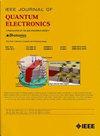通过旋转衍射光栅实现宽调谐范围的长波红外线 ZnGeP2 光参量振荡器
IF 2.2
3区 工程技术
Q3 ENGINEERING, ELECTRICAL & ELECTRONIC
引用次数: 0
摘要
我们报告了一种在长波红外具有宽调谐范围的 ZnGeP $_{{math\bf {2}}$光参量振荡器(OPO)。该 OPO 由峰值功率很高的 Ho: YLF 激光器泵浦,并使用了带有衍射光栅的谐振腔。通过旋转光栅实现了波长为 8.45- $11.37~\mu \text{m}$的可调谐长波激光。同时,在波长为 8.45~11.37 美元(text{m}$)到 9.15~11.37 美元(text{m}$)的可调谐范围内,线宽小于 61 nm。当惰极光的波长为 8.84~mu \text{m}$ 时,最大输出能量为 52.80~mu \text{J}$ ,峰值功率为 6.60 kW。这种新颖的调谐方法为实现可调谐长波光源用于离散气体浓度检测提供了有效途径。本文章由计算机程序翻译,如有差异,请以英文原文为准。
Long-Wave Infrared ZnGeP2 Optical Parametric Oscillator With a Wide Tuning Range by Rotating a Diffraction Grating
We report a ZnGeP
$_{\mathbf {2}}$
optical parametric oscillator (OPO) with a wide tuning range in the long-wave infrared. The OPO was pumped by a Ho: YLF laser with high peak power, and a resonate cavity with a diffraction grating was used. A tunable long-wave laser with the wavelength of 8.45-
$11.37~\mu \text{m}$
was achieved by rotating the grating. Meanwhile, the linewidth was less than 61 nm at the wavelength within the tunable range from
$8.45~\mu \text{m}$
to
$9.15~\mu \text{m}$
. When the wavelength of the idler light was
$8.84~\mu \text{m}$
, the maximum output energy was
$52.80~\mu \text{J}$
, and the peak power was 6.60 kW. The novel tuning method offers an effective way to realize a tunable long-wave source for stand-off gas concentration detection.
求助全文
通过发布文献求助,成功后即可免费获取论文全文。
去求助
来源期刊

IEEE Journal of Quantum Electronics
工程技术-工程:电子与电气
CiteScore
4.70
自引率
4.00%
发文量
99
审稿时长
3.0 months
期刊介绍:
The IEEE Journal of Quantum Electronics is dedicated to the publication of manuscripts reporting novel experimental or theoretical results in the broad field of the science and technology of quantum electronics. The Journal comprises original contributions, both regular papers and letters, describing significant advances in the understanding of quantum electronics phenomena or the demonstration of new devices, systems, or applications. Manuscripts reporting new developments in systems and applications must emphasize quantum electronics principles or devices. The scope of JQE encompasses the generation, propagation, detection, and application of coherent electromagnetic radiation having wavelengths below one millimeter (i.e., in the submillimeter, infrared, visible, ultraviolet, etc., regions). Whether the focus of a manuscript is a quantum-electronic device or phenomenon, the critical factor in the editorial review of a manuscript is the potential impact of the results presented on continuing research in the field or on advancing the technological base of quantum electronics.
 求助内容:
求助内容: 应助结果提醒方式:
应助结果提醒方式:


